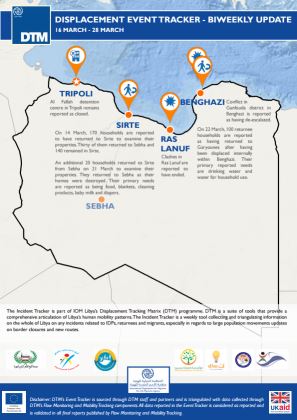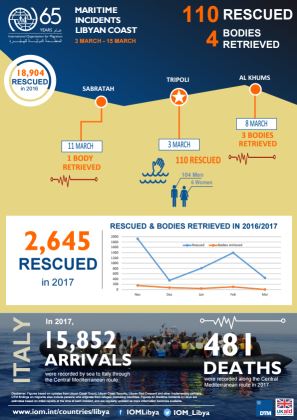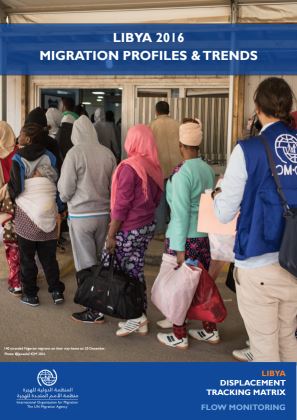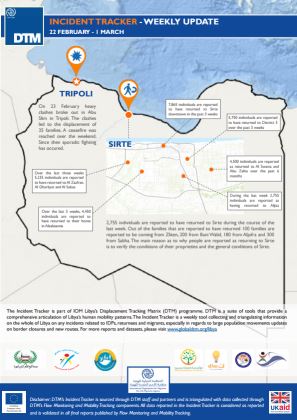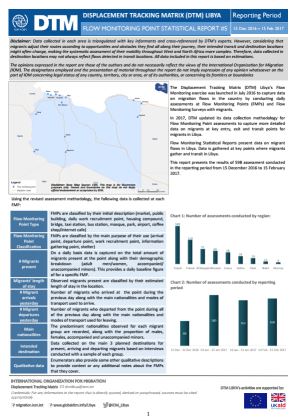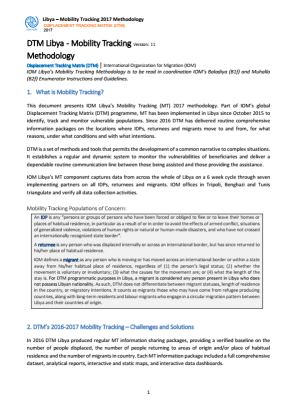-
Countries
-
Data and Analysis
-
Special Focus
-
Crisis Responses
Libya
Sobre Libya
Libya is a geographically vast country with several regions that are difficult to access. In order to understand the full scope of humanitarian assistance that is needed throughout the country, IOM established the Displacement Tracking Matrix (DTM) programme in 2016 in order to provide a common operating picture concerning the movement of populations in Libya, allowing humanitarian actors to provide timely assistance to those in need. Following the escalation of conflict and insecurity in 2014, the security situation has remained volatile since with fluctuations in the intensity of localized clashes. Congruently, conflict has caused new displacements, often in areas ill-equipped to accommodate large population movements while also negatively impacting the large migrant population residing and transiting through Libya. More recently, the capital Tripoli was heavily affected by displacement waves in September 2018 and April 2019.
DTM’s mobility tracking and flow monitoring activities identified many migrants in-country to be in need of various forms of assistance. Libya’s geographic location, resources and work opportunities has made it both a country of destination and transit for migrants for many years. Despite the deterioration of the security situation since 2011 migrants continue coming to and transiting through Libya, the majority from Sub-Saharan and North African countries.
In this complex operating environment, DTM Libya has been providing a common operating picture concerning the movement of populations in Libya since 2016, allowing humanitarian actors to provide timely assistance to those in need. Through its mobility tracking, flow monitoring and needs assessment activities, DTM Libya has established itself as data hub for quantitative data on migratory flows to and within Libya, migrant presence in Libya disaggregated by nationality and area, as well as humanitarian needs of migrants, internally displaced population and returnees. All activities are implemented through periodical bi-monthly data collection cycles, allowing trend analysis over time to provide evidence-base for both policy-level discussions and to guide humanitarian action.
In order to facilitate humanitarian interventions, DTM works closely with IOM’s other programmes through referring identified populations in need of assistance at flow monitoring points to IOM’s Direct Assistance, Health, Voluntary Humanitarian Return (VHR), Protection and Migrant Rapid Response Mechanism (MRRM) programmes. Furthermore, DTM Libya supports other humanitarian partners through providing emergency tracking updates in case of sudden population movements as well as facilitating humanitarian assessments for the Rapid Response Mechanism (RRM) jointly implemented by IOM, UNICEF, WFP and UNFPA.
For more information on IOM's activities in Libya, please visit the IOM Libya country office website.
Contacto
DTM Libya
DTMLibya@iom.int
Current Donors
- EUTF
Para obtener resultados de búsqueda más avanzados, vaya a la Página de búsqueda avanzada de informes
Libya — Maritime Incidents Update (12 – 27 April 2017)
During the reporting period, IOM recorded 28 Men rescued in Zuwara (13 April), five bodies retrieved in Sabarath (18 April), 23 rescued in Tripoli (13 April) as well as 101 rescued and 5 bodies retrieved in Garaboli (15 April).
Migrant Report Key Findings 8 (March 2017)
In Round 8 DTM Libya’s Mobility Tracking identified 4381,463 migrants. Migrants were identified in 99 baladiyas and 444 muhallas. 7,197 migrants were idenfitified as being in detention. 10% of migrants are minors.
Apr 25 2017
Migrant Report Key Findings 8 (March 2017)
Libya — Migrant Report 8 (March 2017)
This report presents two sets of data from two different DTM operations.
Apr 25 2017
Libya — Migrant Report 8 (March 2017)
Libya — Displacement Event Tracking Report (5–19 April 2017)
A total of 63,000 individuals are reported to have returned to Sirte as of 19 April 2017. 150 IDP households were reported to have fled their homes due to clashes in Tamnhnt in the last two weeks.
Libya — Maritime Incidents Update (31 March – 9 April 2017)
During the reporting period 295 people were rescued and 1 body was retrieved. 3,977 individuals have been rescued thus far in 2017.
Libya — IDP and Returnee Report 8 (January — February 2017)
In round 8 DTM Libya interviewed 1,192 key informants across 100 Baladiyas and 661 Muhallas. In total 294,436 IDPs were identified. 26% of these had been displaced during 2011—2014, 42% had been displaced in 2015 and 32% has been displaced in 2016.
Libya — Maritime Incidents Update (16–30 March 2017)
During the reporting period 1,037 people were rescued and 23 bodies were retrieved. 3,682 individuals have been rescued thus far in 2017.
Libya — IDP and Returnee Key Findings Report 9 (February — March 2017)
In March 2017 DTM Libya identified 256,615 IDPs across 656 muhallas and 100 baladiyas. The main driver of displacement was for 96% of surveyed migrants the threat of general conflict and armed group presence.
Maritime Incidents Libyan Coast Update (16 March – 30 March)
During the period covered 1,037 people were rescued and 23 bodies were retrieved. In total 3,682 people have been rescued thus far in 2017 and 595 deaths have been recorded.
Maritime Incidents Libyan Coast Update (30 March 2017)
During this reporting period, 16–30 March, a total of 1,037 migrants were rescued off of the Libyan Coast (409 from Zuwara, 402 from Az-Zawiyah, and 223 from Tripoli) and 23 bodies were retrieved (14 from Az-Zawiyah, 5 from Zuwara, and 4 from Sabratha).
Libya — Displacement Event Tracking Report (16—28 March 2017)
This report is composed of a map indicating significant displacement related events in Tripoli, Sirte, Ras Lanuf and Benghazi.
Libya — Tracking Migrant Flows in Libya (2016—2017)
DTM has tracked the number of migrants in Libya since the start of 2016. This document presents the trends in the number of migrants in 2016-2017.
Libya — Internal Displacement 2016 in Review
DTM was established in Libya in October 2015 to track the movement of IDPs, returnees and migrants. This report is an overview of DTM's mobility tracking activities in Libya accross all seven rounds of assessment.
Mar 17 2017
Libya — Internal Displacement 2016 in Review
Maritime Incidents Libyan Coast Update (3 – 15 March 2017)
From 3 – 15 March 2017 110 individuals were rescued and 4 bodies were retrieved. Of those rescued 104 were men and 6 were women. A total of 2,645 individuals were rescued in 2017.
Libya — Displacement Event Tracking Report (2—15 March 2017)
This report consists of a map indicating displacement events across Tripoli, Sirte, Nofaliya, Al Qatrun.
Libya — Migration Profiles and Trends (2016)
During this reporting period IOM Libya conducted 8,306 interviews using simple random sampling across 10 different regions, some consisting of several Flow Monitoring Points.
Mar 02 2017
Libya — Migration Profiles and Trends (2016)
Libya — Displacement Event Tracking Report (22 February — 1 March 2017)
On 23 February heavy clashes broke out in Abu Slim in Tripoli. The clashes led to the displacement of 35 families. 2,755 individuals are reported to have returned to Sirte during the course of the last week.
Maritime Incidents Libyan Coast Update (2 – 15 February 2017)
During the period covered 592 people were rescued and 0 bodies were retrieved. A total of 1,400 people have been rescued so far in 2017. A total of 9,448 arrivals by sea to Italy through the Central Mediterranean route have been recorded so far in 2017.
Libya — Flow Monitoring Statistical Report 5 (15 December 2016—15 February 2017)
Flow Monitoring Statistical Reports present data on migrant flows in Libya. Data is gathered at key points where migrants gather and transit in Libya. This report presents the results of 598 assessments conducted in the reporting period from 15 December 2016 to 15 February 2017.
Maritime Incidents Libyan Coast Update (19 January – 1 February 2017)
During the period covered 624 people were rescued and 16 bodies were retrieved. A total of 808 people have been rescued so far in 2017. A total of 4,480 arrivals by sea to Italy were recorded thus far in 2017.
DTM Libya - Mobility Tracking Methodology
This document presents DTM Libya Mobility Tracking methodology, IOM Libya’s Mobility Tracking Methodology is to be read in coordination IOM’s Baladiya (B1F) and Muhalla (B2F) Enumerator Instructions and Guidelines.
Jan 01 2017
DTM Libya - Mobility Tracking Methodology
DTM Libya - Flow Monitoring Methodology
This document presents DTM Libya Flow Monitoring methodology, the Baseline Assessment V.11 forms with notes and guidelines, and IOM’s 5.1 DTM Flow Monitoring Survey form.
Jan 01 2017
DTM Libya - Flow Monitoring Methodology
Libya — 2016 Migration Profiles and Trends
This report presents a cumulative quantitative analysis of baseline data and migrant-focused DTM surveys carried out between the 12th of July and the 15th of December, 2016.
Jan 01 2017
Libya — 2016 Migration Profiles and Trends
Libya — Flow Monitoring Statistical Report 4 (21 November 2016 — 11 December 2016)
This report includes the finding of the data collected trough 43 assessments conducted in Libya between 21 November and 11 December in 6 different FMPs. In this reporting period, 775 migrants were identified across 6 FMPs in 3 areas.
Pagination
Para obtener resultados de búsqueda más avanzados, vaya a la Página de búsqueda avanzada de conjuntos de datos
Pagination
- First page
- Previous page
- 1
- 2
- 3
- 4
- 5












